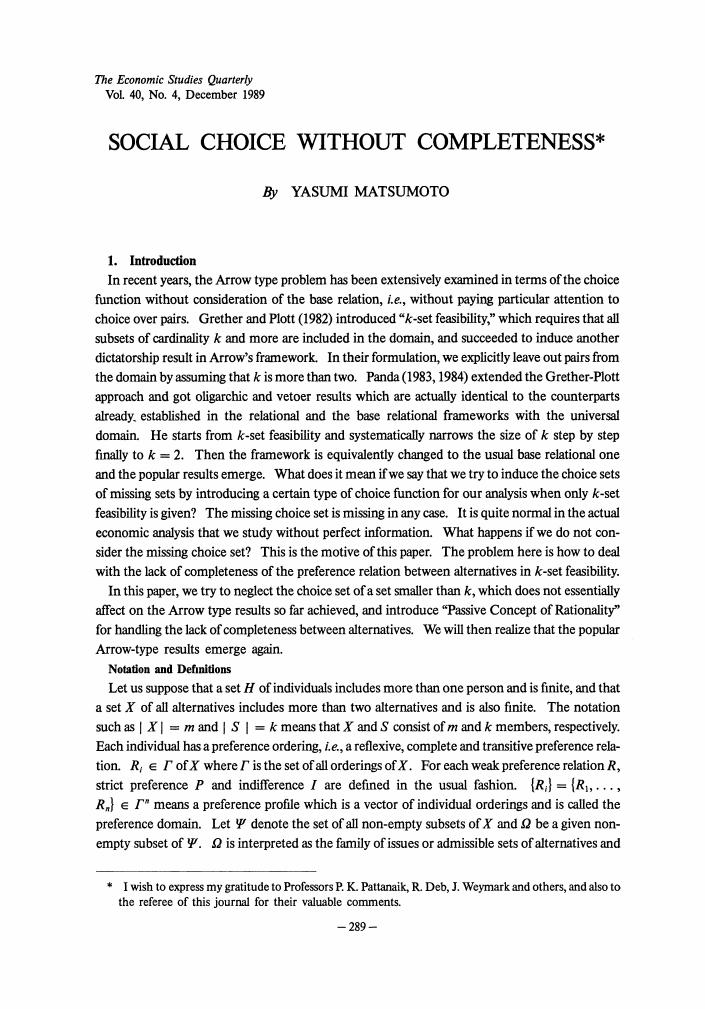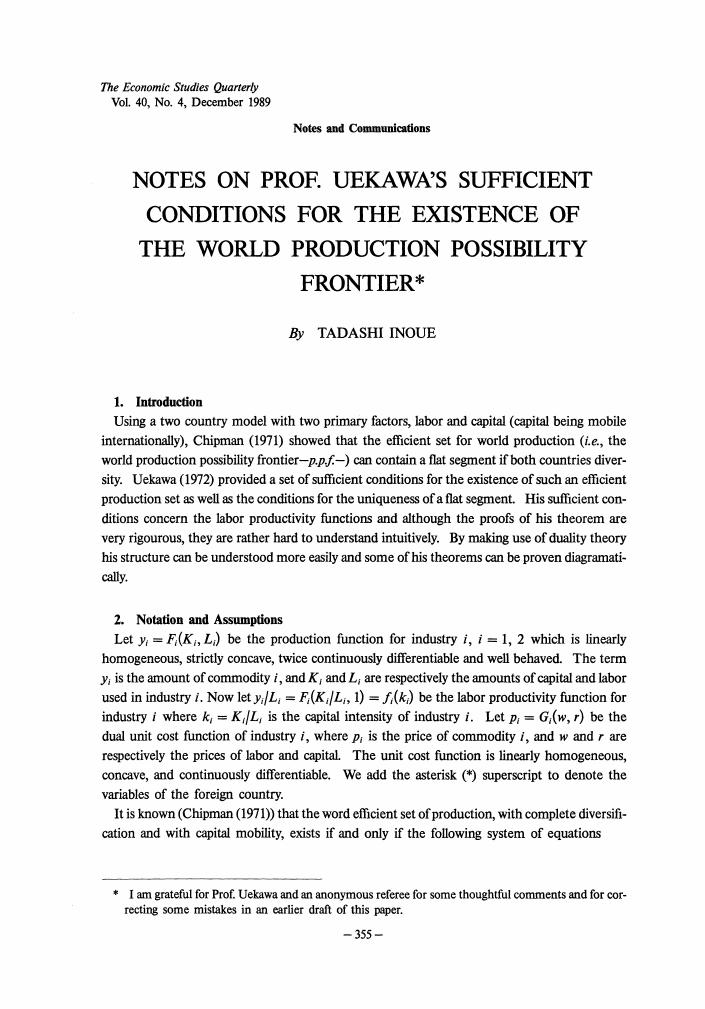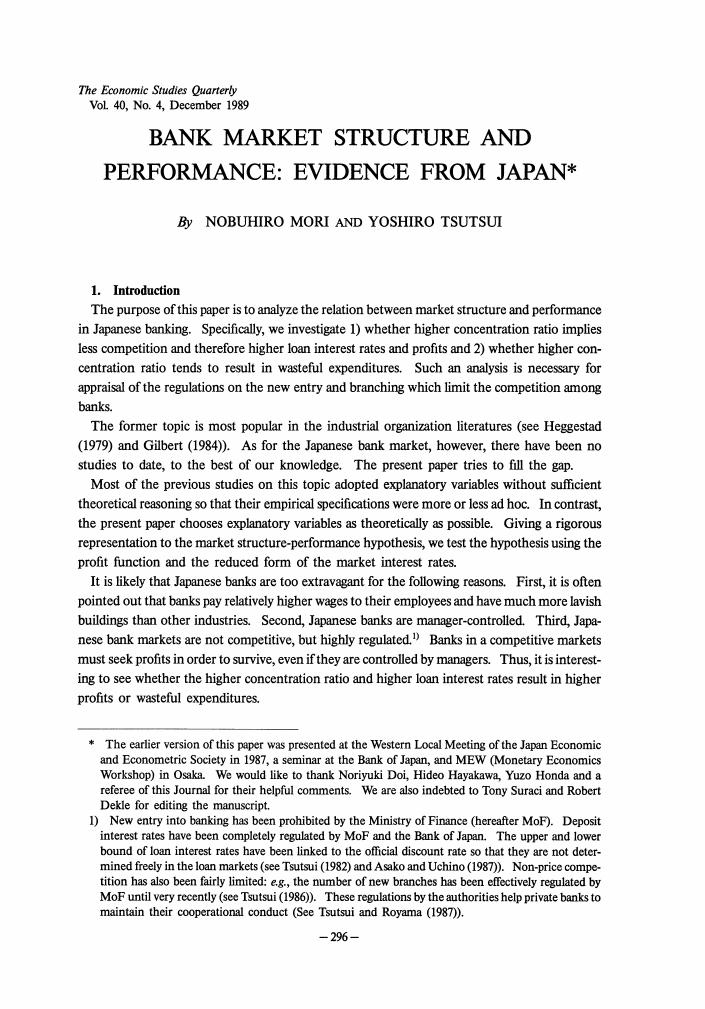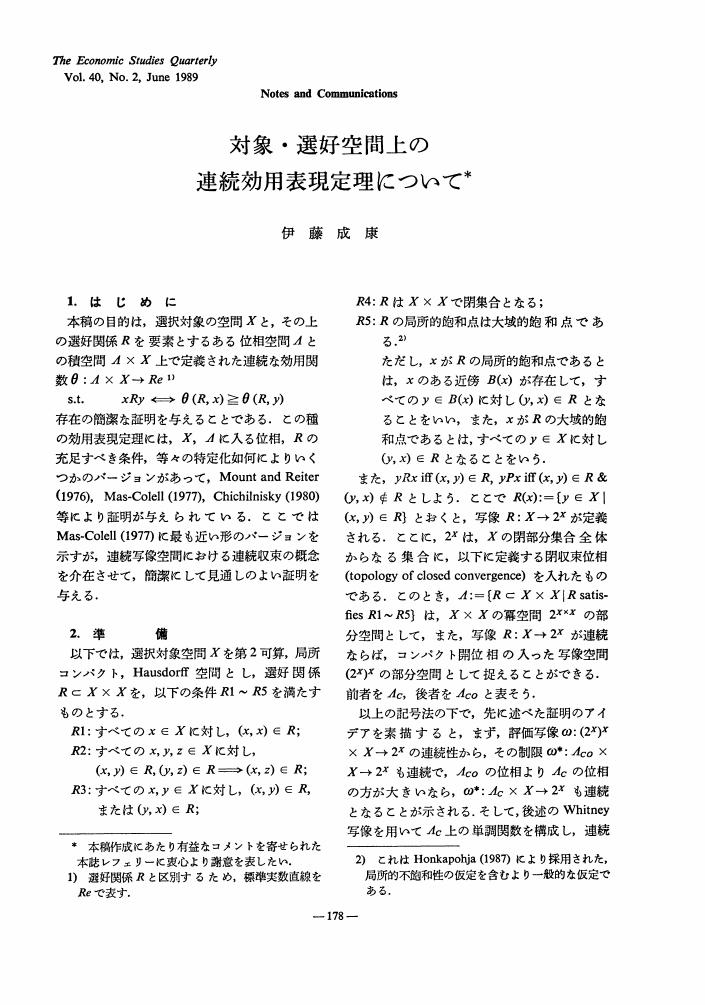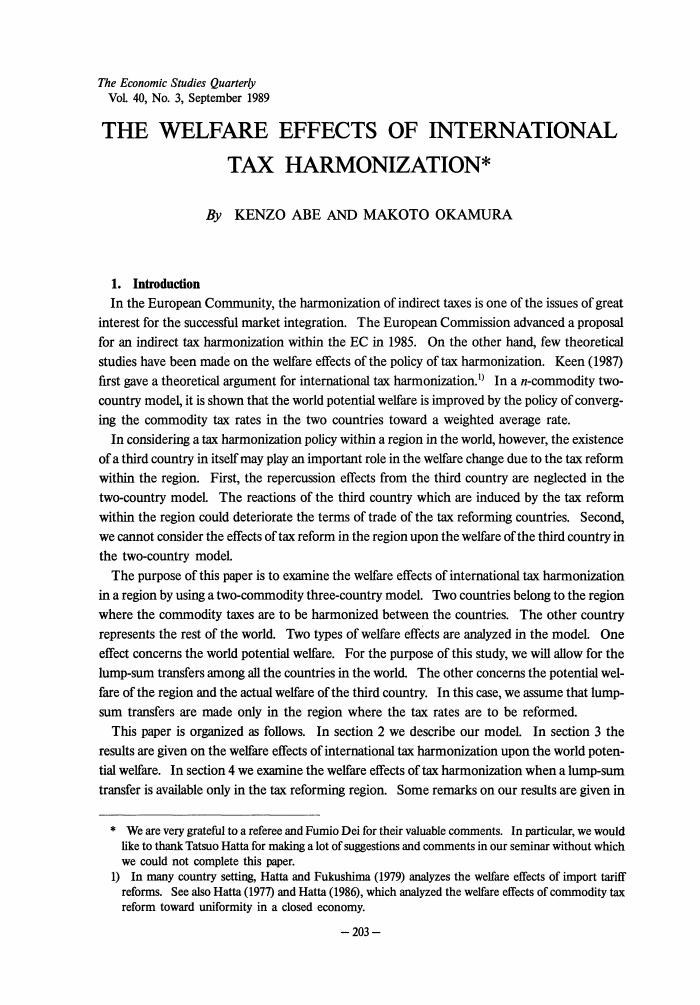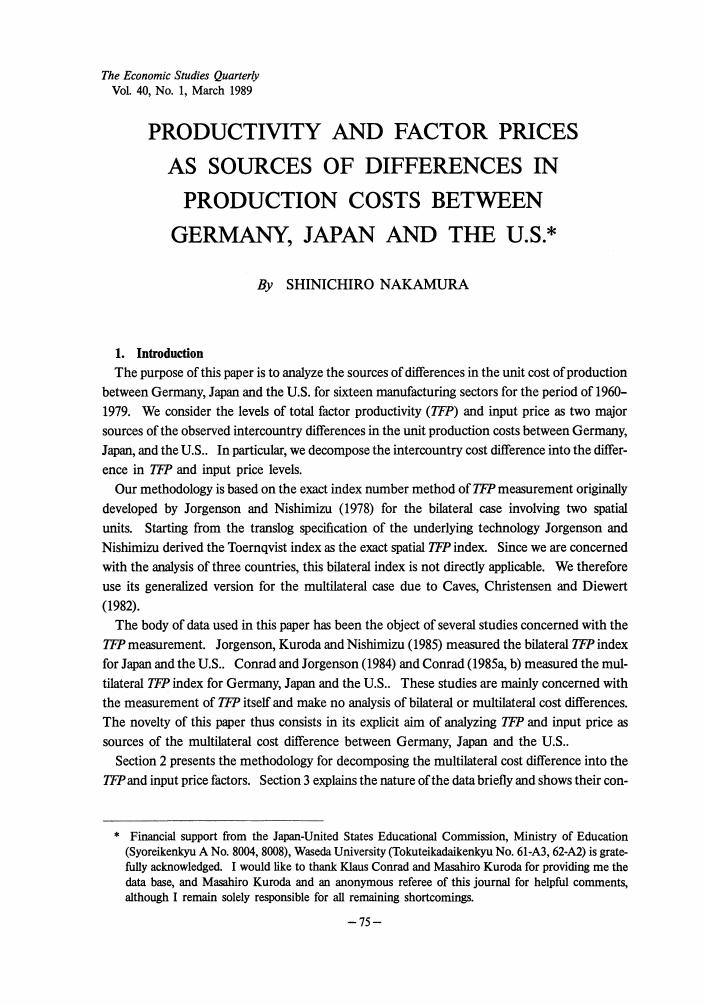- 著者
- TOSHIHIRO IHORI
- 出版者
- JAPANESE ECONOMIC ASSOCIATION
- 雑誌
- The Economic Studies Quarterly (ISSN:0557109X)
- 巻号頁・発行日
- vol.40, no.3, pp.251-263, 1989-09-20 (Released:2007-10-19)
- 参考文献数
- 16
- 著者
- HIDEKI NISHIOKA
- 出版者
- JAPANESE ECONOMIC ASSOCIATION
- 雑誌
- The Economic Studies Quarterly (ISSN:0557109X)
- 巻号頁・発行日
- vol.40, no.3, pp.264-275, 1989-09-20 (Released:2007-10-19)
- 参考文献数
- 14
- 著者
- ATSUSHI TSUNEKI
- 出版者
- JAPANESE ECONOMIC ASSOCIATION
- 雑誌
- The Economic Studies Quarterly (ISSN:0557109X)
- 巻号頁・発行日
- vol.40, no.3, pp.276-288, 1989-09-20 (Released:2007-10-19)
- 参考文献数
- 32
1 0 0 0 OA SOCIAL CHOICE WITHOUT COMPLETENESS
- 著者
- YASUMI MATSUMOTO
- 出版者
- JAPANESE ECONOMIC ASSOCIATION
- 雑誌
- The Economic Studies Quarterly (ISSN:0557109X)
- 巻号頁・発行日
- vol.40, no.4, pp.289-295, 1989-12-20 (Released:2007-10-19)
- 参考文献数
- 7
- 著者
- OSAMU ICHIOKA TOSHIAKI TACHIBANAKI
- 出版者
- JAPANESE ECONOMIC ASSOCIATION
- 雑誌
- The Economic Studies Quarterly (ISSN:0557109X)
- 巻号頁・発行日
- vol.40, no.4, pp.317-335, 1989-12-20 (Released:2007-10-19)
- 参考文献数
- 21
- 著者
- TAKASHI FUKUSHIMA
- 出版者
- JAPANESE ECONOMIC ASSOCIATION
- 雑誌
- The Economic Studies Quarterly (ISSN:0557109X)
- 巻号頁・発行日
- vol.40, no.4, pp.349-354, 1989-12-20 (Released:2007-10-19)
- 参考文献数
- 8
- 著者
- TADASHI INOUE
- 出版者
- JAPANESE ECONOMIC ASSOCIATION
- 雑誌
- The Economic Studies Quarterly (ISSN:0557109X)
- 巻号頁・発行日
- vol.40, no.4, pp.355-363, 1989-12-20 (Released:2007-10-19)
- 参考文献数
- 2
- 著者
- NOBUHIRO MORI YOSHIRO TSUTSUI
- 出版者
- JAPANESE ECONOMIC ASSOCIATION
- 雑誌
- The Economic Studies Quarterly (ISSN:0557109X)
- 巻号頁・発行日
- vol.40, no.4, pp.296-316, 1989-12-20 (Released:2007-10-19)
- 参考文献数
- 24
1 0 0 0 OA 開放経済の在庫マクロモデル
- 著者
- 柳田 辰雄
- 出版者
- 日本経済学会
- 雑誌
- The Economic Studies Quarterly (ISSN:0557109X)
- 巻号頁・発行日
- vol.40, no.2, pp.166-177, 1989-06-20 (Released:2007-10-19)
- 参考文献数
- 10
Economists have two major stands in international monetary economics. One is the monetary approach, the other is the asset market approach. This paper trys to integrate the two approach, by introducing a goods inventory as an asset. Dornbusch (1976) analyzed an interaction between an asset and a good market by postulating that the asset market is continuously in equilibrium, while the goods market adjust slowly to equilibrium. By this model, he explained the observed volatility and overshooting of exchange rates. His model, however, accomodates price adjustment but ignored quantity adjustment in the goods market. In this paper, I present a general framework for an open economy analysis, by modeling an open economy with a goods inventory, similar to Van Duyne (1979). In this model, a goods inventory functions not only as a buffer between effective demand and output but also as an asset. The asset market has money, a goods inventory, domestic bonds and foreign bonds. Assuming perfect substitutability between domestic and foreign bonds, interest rate parity is introduced. Major lessons of the paper are as follows. In a small open economy with a goods inventory as an asset, an increase in the foreign interest rate increases the domestic interest rate, decreases the price of the goods inventory, and depreciates the current exchange rate in the short run, and thereby decreases income and improves current account in the medium run. A monetary expansion increases the goods inventory price, decreases the interest rate, and thereby increases income and improves current account. An increase in a tax-financed government expenditure does not change the asset prices in the short run, and in the long run increases income and deteriorates current account due to an increase in domestic absorption.
1 0 0 0 OA 対象•選好空間上の連続効用表現定理について
- 著者
- 伊藤 成康
- 出版者
- 日本経済学会
- 雑誌
- The Economic Studies Quarterly (ISSN:0557109X)
- 巻号頁・発行日
- vol.40, no.2, pp.178-182, 1989-06-20 (Released:2007-10-19)
- 参考文献数
- 10
- 著者
- TATSUO HATTA
- 出版者
- JAPANESE ECONOMIC ASSOCIATION
- 雑誌
- The Economic Studies Quarterly (ISSN:0557109X)
- 巻号頁・発行日
- vol.40, no.3, pp.193-194, 1989-09-20 (Released:2007-10-19)
1 0 0 0 OA MULTILATERAL TAX AND TARIFF REFORM
- 著者
- MICHAEL KEEN
- 出版者
- JAPANESE ECONOMIC ASSOCIATION
- 雑誌
- The Economic Studies Quarterly (ISSN:0557109X)
- 巻号頁・発行日
- vol.40, no.3, pp.195-202, 1989-09-20 (Released:2007-10-19)
- 参考文献数
- 15
1 0 0 0 OA TAXATION OF COMPENSATING WAGE VARIATION
- 著者
- BRUCE W. HAMILTON PAUL T. DECKER
- 出版者
- JAPANESE ECONOMIC ASSOCIATION
- 雑誌
- The Economic Studies Quarterly (ISSN:0557109X)
- 巻号頁・発行日
- vol.40, no.3, pp.239-250, 1989-09-20 (Released:2007-10-19)
- 参考文献数
- 23
1 0 0 0 OA WHY NOT TAX UNIFORMLY RATHER THAN OPTIMALLY?
- 著者
- TAKASHI FUKUSHIMA TATSUO HATTA
- 出版者
- JAPANESE ECONOMIC ASSOCIATION
- 雑誌
- The Economic Studies Quarterly (ISSN:0557109X)
- 巻号頁・発行日
- vol.40, no.3, pp.220-238, 1989-09-20 (Released:2007-10-19)
- 参考文献数
- 29
- 著者
- HIDEO KONISHI
- 出版者
- JAPANESE ECONOMIC ASSOCIATION
- 雑誌
- The Economic Studies Quarterly (ISSN:0557109X)
- 巻号頁・発行日
- vol.40, no.3, pp.212-219, 1989-09-20 (Released:2007-10-19)
- 参考文献数
- 6
- 著者
- KENZO ABE MAKOTO OKAMURA
- 出版者
- JAPANESE ECONOMIC ASSOCIATION
- 雑誌
- The Economic Studies Quarterly (ISSN:0557109X)
- 巻号頁・発行日
- vol.40, no.3, pp.203-211, 1989-09-20 (Released:2007-10-19)
- 参考文献数
- 9
- 著者
- PAUL D. THISTLE
- 出版者
- JAPANESE ECONOMIC ASSOCIATION
- 雑誌
- The Economic Studies Quarterly (ISSN:0557109X)
- 巻号頁・発行日
- vol.40, no.2, pp.183-187, 1989-06-20 (Released:2007-10-19)
- 参考文献数
- 7
1 0 0 0 OA SEARCH WHILE CONSUMING
- 著者
- R. MANNING
- 出版者
- JAPANESE ECONOMIC ASSOCIATION
- 雑誌
- The Economic Studies Quarterly (ISSN:0557109X)
- 巻号頁・発行日
- vol.40, no.2, pp.97-108, 1989-06-20 (Released:2007-10-19)
- 参考文献数
- 22
- 著者
- TOSHIHIRO IHORI
- 出版者
- JAPANESE ECONOMIC ASSOCIATION
- 雑誌
- The Economic Studies Quarterly (ISSN:0557109X)
- 巻号頁・発行日
- vol.40, no.1, pp.66-74, 1989-03-20 (Released:2007-10-19)
- 参考文献数
- 16
- 著者
- SHINICHIRO NAKAMURA
- 出版者
- JAPANESE ECONOMIC ASSOCIATION
- 雑誌
- The Economic Studies Quarterly (ISSN:0557109X)
- 巻号頁・発行日
- vol.40, no.1, pp.75-89, 1989-03-20 (Released:2007-10-19)
- 参考文献数
- 13



